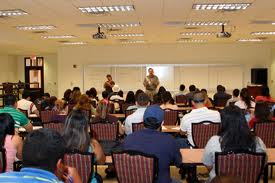
Over the year, I have been in many churches and many conferences in which I have been asked one of the many variations of this question: How large should a Sunday School class be? I have written about this issue previously: Ideal Sunday School Class Size Issues for Spiritual Progress and Class Size vs Room Size.
In addition to what I have written, I like a recent post by my friend Mark Miller, the State Sunday School Director and Discipleship and Small Groups Specialist for the Tennessee Baptist Convention. Mark has written How Big Should a Sunday School Class Be? Mark communicates well many of the very statements I have made in response to this question.
After sharing the “traditional textbook answer,” Mark says the following:
But it really does depend. For example, my experience is that a dynamic takes place when a Coed Sunday School class begins to average around 16-20. But when these same classes grow must past 35, they begin to become complacent. They are guaranteed a decent attendance each week, so often the ministry of the class begins to be taken for granted. My church allows space to dictate our class size, when a classroom is 80% full, the goal is to start a new class within 3 months….
Allan Taylor utilizes the Parable of the Talents and says that there are 1 talent teachers, two talent teachers, and five talent teachers. Teachers of all teaching levels are needed and appreciated but this impacts class size.
Large classes and Master Teacher classes can be detrimental to the Sunday School movement and the growth of a Sunday School. The key words in the previous sentence is “can be”, because it depends. Usually large classes are taught by teachers who are strong communicators and have a gift for teaching. Many large classes have become small churches inside a church. When this happens, it is easy for Sunday School to become an event that takes place on Sunday morning instead of a strategy for growing the church. Teachers of large classes must work hard to reproduce leaders and birth new classes and to make sure that the class stays connected and relational.
I would strongly encourage having more classes that average between 10-20. In fact, a great ratio for most churches is that you have a class for every ten persons in attendance with your enrollment almost twice the attendance. Remember some classes will be larger and some will be smaller.
So maybe my best response to the question is this one: The ideal class size is the one which enables the class to help the church carry out the Great Commission to “make disciples of all nations.” In other words, if a class can reach, teach, and care for people and build disciplemakers, then the class size is not an issue. But if the class stops reaching out, stops caring for each other, or becomes focused on itself, then the class size may be a contributing factor.
One way to prevent class size from becoming an issue is make sure the teacher is developing an apprentice and leading the class to prepare to start another class. That effort tends to lead the class to reach out, care for each other, and focus on Kingdom issues.
I encourage you to read the rest of Mark Miller’s blog post, How Big Should a Sunday School Class Be?. Then I e ncourage you to evaluate your class or Sunday School. How is class size impacting disciplemaking? Pray. Lead. Adjust. Train. Encourage. Be revolutionary!
Leave a Reply